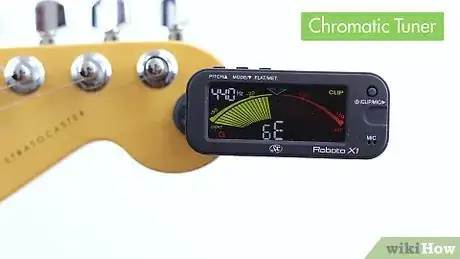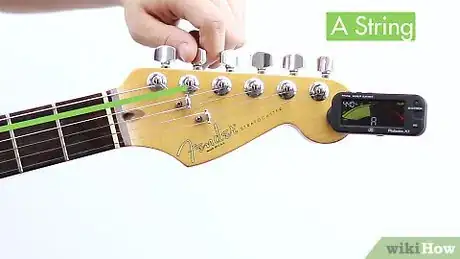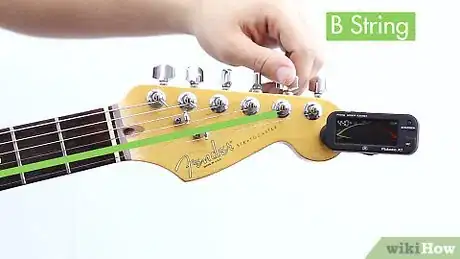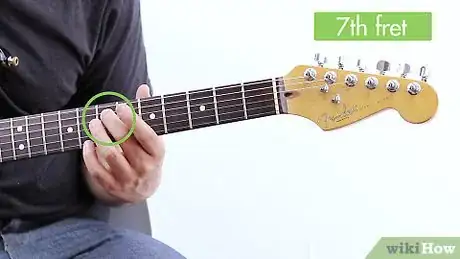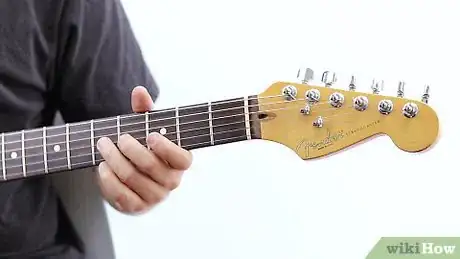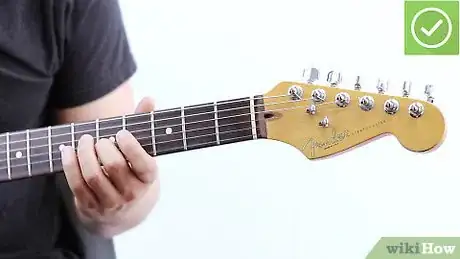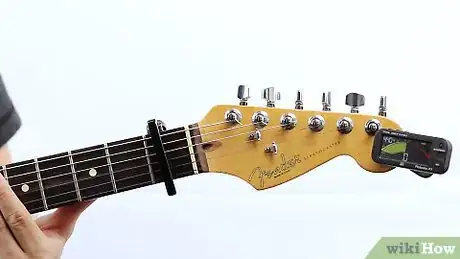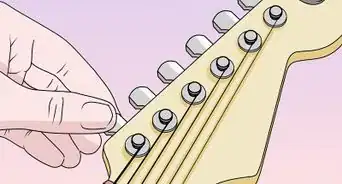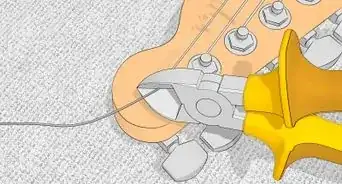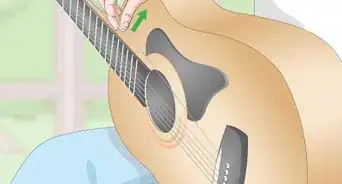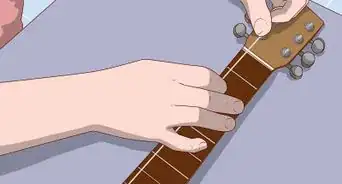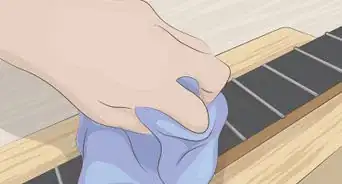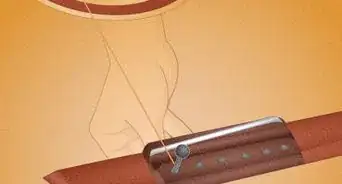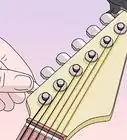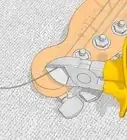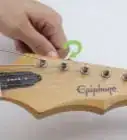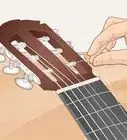This article was co-authored by Carlos Alonzo Rivera, MA. Carlos Alonzo Rivera is a guitarist, composer, and educator based in San Francisco, California. He holds a Bachelor of Arts degree in Music from California State University, Chico, as well as a Master of Music degree in Classical Guitar Performance from the San Francisco Conservatory of Music. Carlos specializes in the following genres: classical, jazz. rock, metal and blues.
wikiHow marks an article as reader-approved once it receives enough positive feedback. In this case, several readers have written to tell us that this article was helpful to them, earning it our reader-approved status.
This article has been viewed 686,383 times.
Many guitarists' hearts sink when they see tune a half step down at the top of tabs. This can be a pain in the neck if you're not used to tuning your guitar into different keys. It also adds wear to your guitar's truss-rod in the neck. Don't be intimidated to play and tune to Eb. This is a great way to experiment with your guitar's sound and add a deeper tone to your guitar.
Steps
Tuning with a Chromatic Tuner
-
1Find a chromatic tuner. It is not necessary to go out and spend $60+ on a chromatic tuning pedal. If you have a smartphone, there are plenty of applications that cost anywhere from $0 to $3. Invest in a chromatic tuning pedal if you plan to perform live a fair amount.[1]
-
2Start with your low E. It doesn't matter if your E is out of tune because you're going to change it anyway. Tune your low E string down until the screen reads Eb or D#.[2]Advertisement
-
3Tune your A string.[3] Tune down your A string until the screen either reads Ab or G#. Don’t tune too fast or else you could pass Ab and become lost.
-
4Detune your D string. Tune your D string down until the screen of the tuner says Db or C#. Use a relaxed pace when tuning down your string.
-
5Fix the G String. Tune your G string down until the tuner says Gb or F#.[4]
-
6Tune the B string. Lower the B string’s note until the tuner says Bb or A#.[5]
-
7Tune the high E string. Detune the E string at slow pace until the screen reads Eb or D#.[6]
-
8Recheck each string. Usually after detuning all your strings your guitar will not hold the new tuning at first. Go through each string and make sure they are all in tune to EbAbDbGbBbEb or D#G#C#F#A#D#.[7]
- You might need to check the tune of each string a few times.
- Test the tuning by playing a chord. Pluck each string in the chord and make sure each string sounds in tune.
Using Your Guitar and Ears
-
1Check the tuning of your guitar. Make sure that you are in standard tuning. You'll tune down a half step to whatever you are currently tuned to if not.
-
2Start on the A string. Play the 4th fret on the low "E" string. This is an Ab. Tune the "A" string down until it sounds the same as the "E" on the 4th fret. The "A" is now an "Ab".
-
3Fix the low E string. Play the 7th fret on the A string. This note is an Eb. Play the E string open and the A string on the seventh fret. Tune up the low E until the sound matches the A string on the seventh fret.
-
4Finish tuning the rest of the strings. After tuning the low E and A strings, tune like you would normally. Follow this order:
- Tune the 4th string to the 5th fret of the 5th string.
- Tune the 3rd string to the 5th fret of the 4th string.
- Tune the 2nd string to the 4th fret of the 3rd string.
- Tune the 1st string to the 5th fret of the 2nd string.
-
5Double check your tuning. If you have the means, use an app or website that has a tuner and check your tuning. Tuning your guitar down a half step changes your guitar neck's tension. It'll need time to settle before holding a new tuning.
Using a Capo
-
1Place the capo on the first fret. Capo's are easy tools that help shift between different keys. They're usually used to play in a different key or voice, without changing the tuning. When the capo is on the first fret the low E will instead be an "F."
- You'll tune the guitar into standard tuning, which is a half step lower than the first fret. Then when you remove the capo, you'll be tuned a half step lower.
-
2Find a tuner or a piano. Tune the first string down to an E. If you are using a piano, play an E note and match the low E string to that note. Take it slow and make sure the notes are synchronized.[8]
- This can be a good technique if your tuner is not chromatic. Chromatic tuners hit all the notes including sharps and flats.
-
3Tune the rest of the guitar normally. Go through each string either using a tuner, piano, or your ear. Play a standard E chord and check to see if everything sounds tuned.
-
4Remove the capo. After adjusting your tuning, you should now be tuned down a half step. Play an E chord after you've removed the capo.[9]
-
5Adjust the tuning. Go through each string within a chord, and make sure it sounds in tune. Rely on your ears, but you might need to use a tool.
Expert Q&A
-
QuestionHow do you use an electronic guitar tuner?
 Carlos Alonzo Rivera, MACarlos Alonzo Rivera is a guitarist, composer, and educator based in San Francisco, California. He holds a Bachelor of Arts degree in Music from California State University, Chico, as well as a Master of Music degree in Classical Guitar Performance from the San Francisco Conservatory of Music. Carlos specializes in the following genres: classical, jazz. rock, metal and blues.
Carlos Alonzo Rivera, MACarlos Alonzo Rivera is a guitarist, composer, and educator based in San Francisco, California. He holds a Bachelor of Arts degree in Music from California State University, Chico, as well as a Master of Music degree in Classical Guitar Performance from the San Francisco Conservatory of Music. Carlos specializes in the following genres: classical, jazz. rock, metal and blues.
Professional Guitarist To use a guitar tuner, you have to know the names of the strings first. You will start tuning from the low six-string to the top one it's E-A-D-G-B-E. Once you know the names of the strings, you want to tune and play a string and you want it to read the note that is the string. For example, you want to play the string and have it read E on your tuner and with most tuners, there's a meter that reads right in the middle, and you want it to say for example letter "E" in the middle of the tuner.
To use a guitar tuner, you have to know the names of the strings first. You will start tuning from the low six-string to the top one it's E-A-D-G-B-E. Once you know the names of the strings, you want to tune and play a string and you want it to read the note that is the string. For example, you want to play the string and have it read E on your tuner and with most tuners, there's a meter that reads right in the middle, and you want it to say for example letter "E" in the middle of the tuner. -
QuestionWill that affect how the open chords sound?
 Community AnswerYes, because the strings are in a different tuning and therefore the open chords will sound different.
Community AnswerYes, because the strings are in a different tuning and therefore the open chords will sound different. -
QuestionWhat about A-440 vs A-430?
 Community AnswerTuning your guitar to E flat is roughly the equivalent of tuning to A-415. You can see that 430 is somewhere between those two. It might not make a noticeable difference in tone, but if the rest of the band tunes to 430 as well, it will sound fine.
Community AnswerTuning your guitar to E flat is roughly the equivalent of tuning to A-415. You can see that 430 is somewhere between those two. It might not make a noticeable difference in tone, but if the rest of the band tunes to 430 as well, it will sound fine.
References
- ↑ http://rikkyrooksby.com/2014/03/26/detuning-guitars/
- ↑ Carlos Alonzo Rivera, MA. Professional Guitarist. Expert Interview. 27 August 2019.
- ↑ Carlos Alonzo Rivera, MA. Professional Guitarist. Expert Interview. 27 August 2019.
- ↑ Carlos Alonzo Rivera, MA. Professional Guitarist. Expert Interview. 27 August 2019.
- ↑ Carlos Alonzo Rivera, MA. Professional Guitarist. Expert Interview. 27 August 2019.
- ↑ Carlos Alonzo Rivera, MA. Professional Guitarist. Expert Interview. 27 August 2019.
- ↑ http://rikkyrooksby.com/2014/03/26/detuning-guitars/
- ↑ http://www.guitarnoise.com/lessons/the-underappreciated-art-of-using-a-capo/
- ↑ http://www.guitarnoise.com/lessons/the-underappreciated-art-of-using-a-capo/
About This Article
If you need to tune your guitar a half step down, set up a chromatic tuner. Tune your low E string down until the screen reads E flat or D sharp. The A string should become A flat or G sharp, the D string should be D flat or C sharp, the G string should be G flat or F sharp, and the B string should be B flat or A. Finish with the high E string. If you just want to tune your guitar down for one song, consider clamping a capo onto the first fret of your guitar. If you want to learn how to tune your guitar down by ear, keep reading the article!
